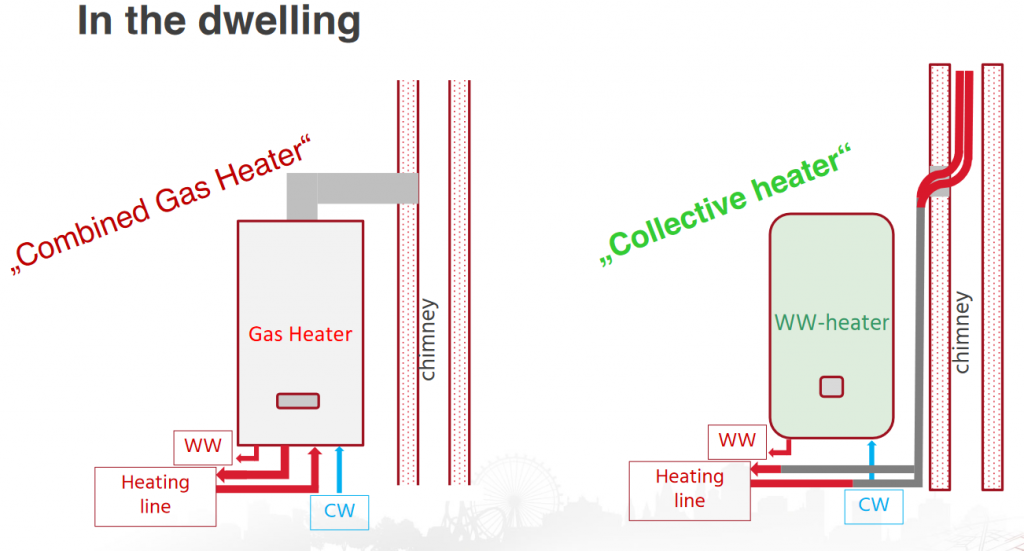There is no technical barrier to remove individual gas boilers in condominiums!

© Sigmund
A number of cities’ strategies to decarbonise heating in existing buildings rely on energy efficiency measures and replacement of fossil-fuel boilers by heating systems powered by green energy, such as heat pumps and district heating (DH).
If this replacement or connection to DH can be done relatively easily in individual houses, the challenge is bigger for multi-apartment buildings in which each flat is equipped with an individual gas boiler. In particular it requires important piping work in buildings. Which smart technical approaches and solutions exist in condominiums to phase-out natural boilers?
Connection to district heating is the cheapest option to replace individual gas boilers in Vienna
In a study commissioned in 2020 by the energy planning department of the City of Vienna, Dipl.-Ing. Dr. Peter Holzer, working for the Institute of Building Research and Innovation, evaluated different options to replace existing gas boilers in condominiums: connection to district heating, installation of collective pellet boiler, collective air-source or geothermal-source heat pump and installation of individual heat pumps. Based on the examples of eight existing multi-family buildings in Vienna (plus six modelised buildings) and the prices from 2020, the average costs of the work range from €85/m2 to €210/m2, i‧e. from €6,000 to €14,700 per flat.

The cheapest option is the connection of the building to district heating, while the most expensive is the replacement of gas boilers with individual heat pumps. Connection to district heating allows to keep using existing radiators most of the time if the district network provides water with a temperature higher than 70°C. Another learning is that there is no significant difference in cost between the installation of individual and collective heat pumps. Specific difficulties may arise for the replacement by heat pumps, such as the need to replace existing radiators with low-temperature ones, or to install heat-pump condensers on the roof because of the lack of space or noise issues. This would increase average costs by around €35/m2. On the other hand, switching to heat pumps can offer the opportunity to provide cooling by installing reversible heat pumps. Watch the recording of the study presentation below!
Innovative approaches can reduce costs of pipping works to connect multi-family buildings to district heating
The main cost to connect condominiums equipped with individual gas boilers to district heating is the installation of water pipes between the flats and the district heating substation. To reduce this cost, SozialBau AG, the biggest not-for-profit housing association in Austria, reuses old chimney ducts wherever possible to install water pipes while reducing impacts on tenants.

To reduce the costs of the water pipes’ installation, Mijnwater utility designed an innovative prototype of an external column to be installed in front of each building to connect district heating networks coming from the street to each individual flat at each storey. The Minjwater concept is based on a very low-temperature district heating network (around 15-25°C) combined with individual heat pumps to boost water temperature to 60°C, allowing very high energy performance. While this concept of an external column has not yet been implemented, Minjwater is confident that it can be a cost-effective solution because this is a modular approach based on industrially prefabricated elements which can be easily adapted to all types of buildings.
Key takeaways
The removal of gas boilers in condominiums is technically possible without exception. There are challenges, but no technical impossibility. While technical innovation is always needed, the main obstacles are financial and regulatory, which should be treated via political decisions and appropriate legal frameworks. Some adaptation of building codes and urban plans might be needed to facilitate the installation of decarbonised heating systems (for instance heat pumps condensers on roofs). More difficult are the financial issues to ensure a just transition and provide the means for vulnerable households to pay for the installation of new systems. Another regulatory change is often the acceptance of reluctant tenants to switch to new fossil-free heating systems, even when the majority of them are ready to start a renovation process. However, strategies exist for cities to boost condominiums’ renovations!
